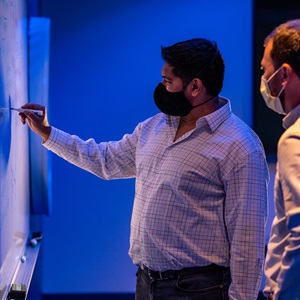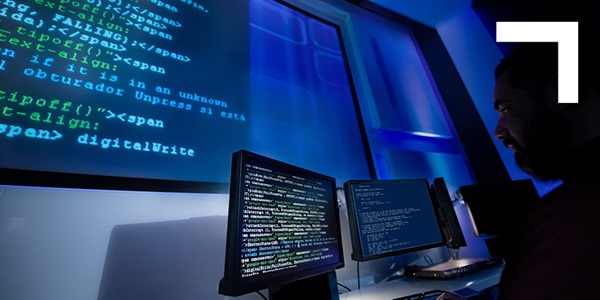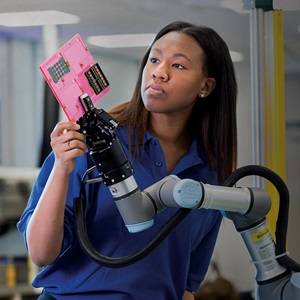What's the Frequency?
An AI Algorithm Can Help with That


By Al McKeon
Drawing on her experience working with survivors of the earthquake and tsunami that devastated Japan nearly a decade ago, Michelle Jin had a eureka moment.
Chaos, disorder and panic can follow a disaster if public communication breaks down. However, Jin realized an AI algorithm could essentially cut through competing radio signals to find a proper frequency that would benefit first responders and victims in a disaster zone.
Jin believed her idea would be well received at Northrop Grumman, where she is a software engineer, but there was one catch: Her department — the satellite program — doesn't focus on this particular use of digital technology. Fortunately, the company doesn't put borders around progress.
Passion for AI Algorithms Results in Funding for New Initiatives
Jin presented her plan during a company-wide initiative called SPARK — a competition that prompts brainstorming and innovation — and won over the crowd. Not only did she receive the funding to develop her AI-supported signal processing algorithm, but she was also promoted. Now, Jin works on initiatives that focus on AI, her driving interest.
"My experience with SPARK has taught me that anyone can be a leader," she said. "All you need to do is take action at that first step."
Cutting Through the Noise
Jin earned a Bachelor of Science degree in computer science from University of California, Santa Cruz, in 2019. When she was a teenager, she volunteered for the Tomodachi Initiative, a non-profit program that sends high school students from the Tohoku region of Japan to a leadership skills and environmental planning course held at the University of California, Berkeley. By the time she was in college, Jin had a paid role with the program, serving as a residential supervisor of the students who were affected by the 2011 disasters in Japan. Their stories about the earthquake and tsunami stayed with her and eventually influenced her idea to find radio frequencies in areas hit by disaster.
Invisible to the eye, radio frequencies support many staples of ordinary life: cell phones, Wi-Fi routers, garage door openers, microwave ovens and remote controls. They also play a critical role in humanitarian missions, supporting communications between emergency responders, governments and aid workers at disaster sites. Yet, discovering the appropriate frequency can be difficult in a disaster zone that's crowded with competing signals.
"It's a big challenge detecting radio signals. AI can be a much more generalizable solution to this problem than all other solutions we've had so far."
— Michelle Jin, Software Engineer
Finding Radio Frequencies using AI
The algorithm processing system Jin developed can parse through radio traffic and extract learning patterns that define frequencies. Jin's hope is that the system will eventually be an integral part of payloads on vehicles such as drones. "It's a big challenge detecting radio signals," she said. "AI can be a much more generalizable solution to this problem than all other solutions we've had so far."
A drone fitted with the system could be sent into disaster-stricken areas, connecting the smaller cell phone signals of rescuers as well as residents on the ground. "Cellphones work off RF (radio frequency) signals. You're able to use cellphones among all the noise" of a disaster, she said. The AI algorithm could identify those signals and even distinguish cell phone carriers. "You can send out emergency cell service drones and bring people back online. And you can find where people are."
Pursuing Your Passions at Northrop Grumman
An Idea That Opened Doors
Recognizing the potential the algorithm has for digital technology initiatives beyond those for humanitarian aid, Jin has expanded the reach of the system to include its use for Northrop Grumman's Department of Defense customer base. The system could support radar and missile systems, enable communication between soldiers and detect nearby radio frequencies to differentiate enemy and friendly signals.
Jin joined forces with Valentin Gazcon, a structural design engineer at Northrop Grumman. They put the system on a small-scale aircraft that Gazcon and his team are developing to allow engineers to demonstrate sensors, such as Jin's receiver, in real-life scenarios before they are applied to full-scale models.
"We have some ideas about what sort of customers would be interested in this," she said. "We're just basically in R-and-D mode right now and in-demo preparation mode for various customers until we get more secure funding."
Jin’s idea has carried her far after less than two years at Northrop Grumman. "It helped me get promoted early on and find my interests and what I want to work on in the company. It opened a lot of doors for me."
More Innovation Stories
Read all stories about advanced technology and innovation >>


